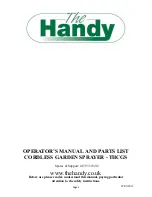
6 308-188
MAINTENANCE
Daily Care and Cleaning
WARNING
Pressure Relief Procedure
To reduce the risk of serious bodily injury, including
splashing in the eyes or on the skin or injury from
moving parts, always follow this procedure when
shutting off the system, when checking or servicing
any part of the spray system, when installing,
cleaning or changing fluid nozzles, and whenever
you stop spraying.
1.
Turn off the air and fluid supply to the gun.
2.
Trigger the gun into a grounded metal waste
container to relieve fluid pressure.
CAUTION
Clean all parts with a solvent compatible with the
fluid being sprayed and compatible with gun wetted
parts. See TECHNICAL DATA on the back page.
To avoid getting solvent in the gun air passages,
NEVER immerse the gun in solvent.
To avoid scratches that can distort the spray pat-
tern, NEVER use metal instruments to clean holes
in the air cap or fluid nozzle .
1.
After operation, flush the gun with a compatible sol-
vent until all traces of paint are removed from the gun
passages. Follow the Pressure Relief Procedure
Warning, at left, before proceeding.
2.
Wipe the outside of the gun clean with a solvent
dampened cloth.
3.
Remove the air cap and fluid nozzle from the gun.
Soak them in solvent and scrub them with a fine,
bristled brush (provided with the gun).
4.
To clean out air cap holes, use a soft implement, such
as a toothpick, to avoid damaging critical surfaces.
Clean the air cap and fluid nozzle daily, minimum.
(Some applications require more frequent cleaning.)
5.
Lubricate the exposed portion of the fluid needle (1)
daily with Graco TSL or light oil. Periodically lubricate
the needle spring (7) and cylinder with light-weight
grease or petroleum jelly. See Fig 3, page 9.
NOTE: The shield (24) helps to minimize over-spray
buildup on the fluid needle (1). Refer to the
PARTS DRAWING.
GUN OPERATION TROUBLESHOOTING CHART
WARNING
To reduce the risk of serious bodily injury, including
splashing fluid or solvent in the eyes or on the skin,
always follow the Pressure Relief Procedure
Warning, above, before checking, adjusting, clean-
ing or repairing the gun or any part of the system.
Disconnect the fluid hose from the gun.
NOTE: Check all possible remedies in the Troubleshoot-
ing Charts before disassembling the gun.
PROBLEM
CAUSE
SOLUTION
Loose needle packing nut(s) (9).
Tighten packing nut(s).
Worn needle packings (10, 16).
Replace packing assemblies.
See page 8.
Fluid leakage from
front of gun.
Fluid needle (1) worn or damaged.
Replace fluid needle. See page 8.
Worn fluid needle and fluid nozzle seat
Replace fluid nozzle (2) and needle (1).
See page 8.
Fluid packing nuts (9) too tight.
Lubricate packings (10, 16) and adjust
packing nuts (9). See page 8.
Leakage from fluid pack-
ing nut.






























